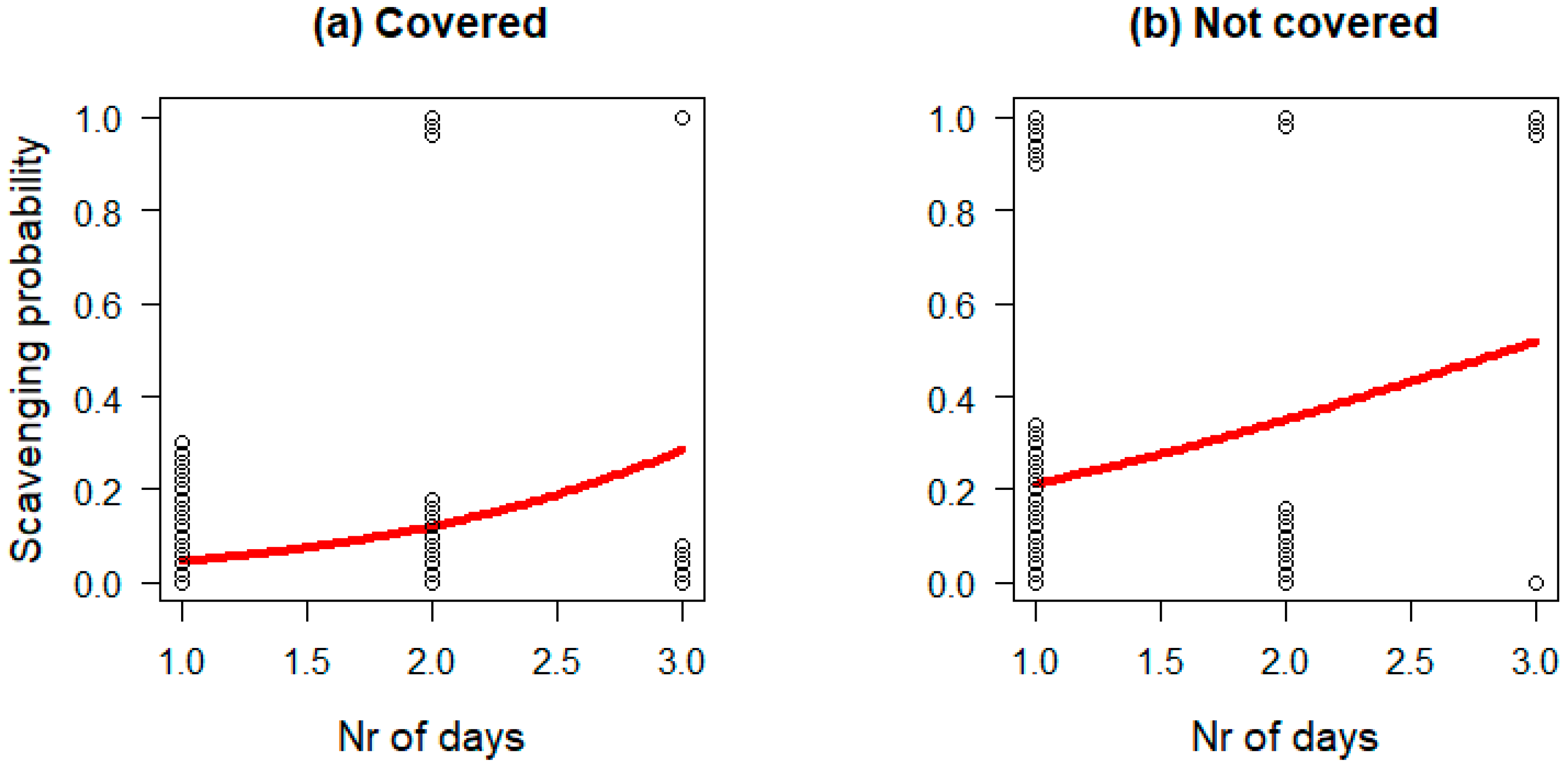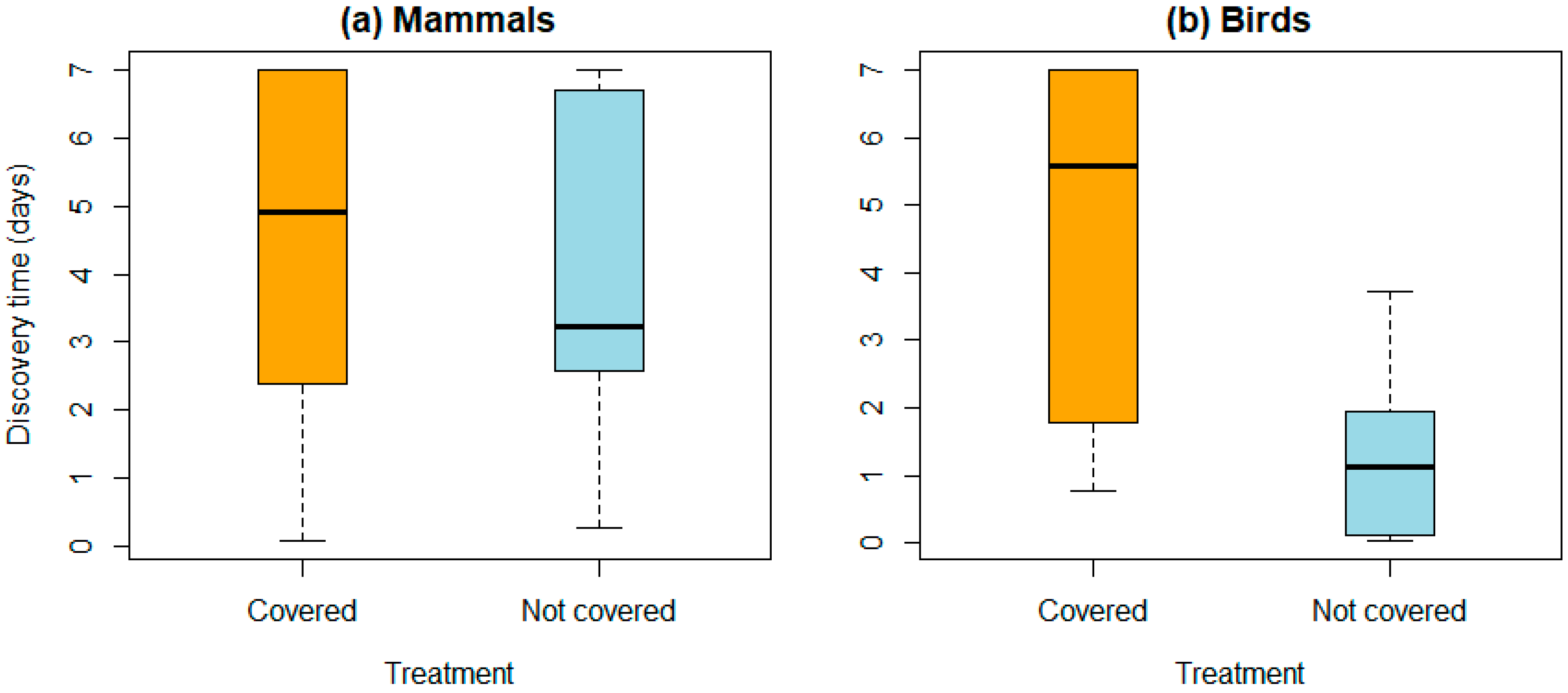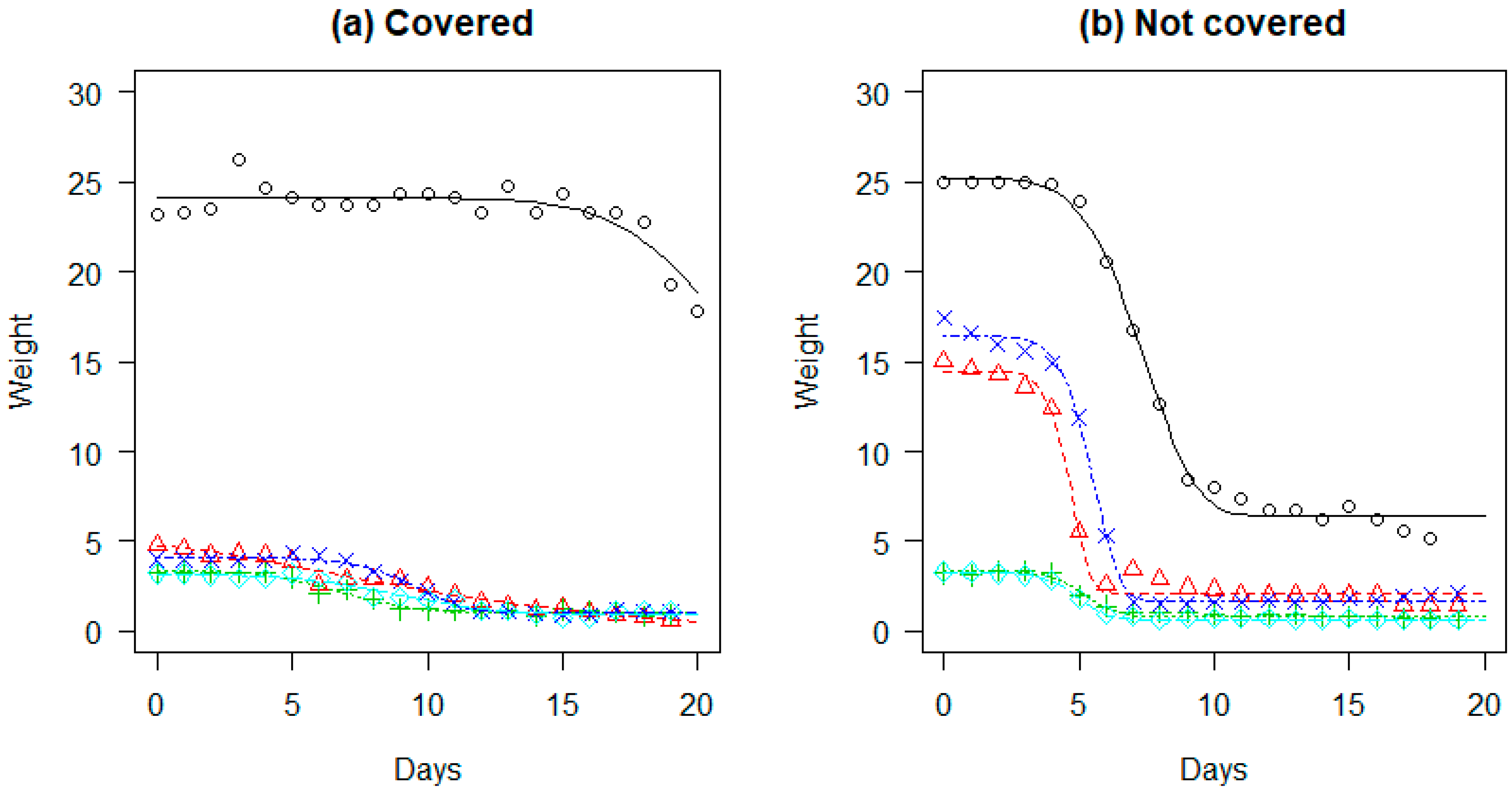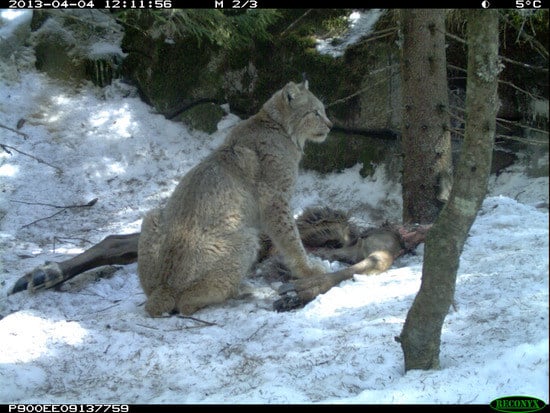Caching Behavior of Large Prey by Eurasian Lynx: Quantifying the Anti-Scavenging Benefits
Abstract
1. Introduction
2. Materials and Methods
2.1. Study Area
2.2. Lynx-Killed Roe Deer
2.3. Experimentally-Deployed Roe Deer Carcasses
2.4. Invertebrate Scavenging Experiments
3. Results
3.1. Lynx-Killed Roe Deer
3.2. Experimentally-Deployed Roe Deer Carcasses
3.3. Insect Scavenging Experiments
4. Discussion
Supplementary Materials
Author Contributions
Funding
Acknowledgments
Conflicts of Interest
References
- Solomon, M.E. The Natural Control of Animal Populations. J. Anim. Ecol. 1949, 18, 1–35. [Google Scholar] [CrossRef]
- Gervasi, V.; Nilsen, E.B.; Sand, H.; Panzacchi, M.; Rauset, G.R.; Pedersen, H.C.; Kindberg, J.; Wabakken, P.; Zimmermann, B.; Odden, J.; et al. Predicting the potential demographic impact of predators on their prey: A comparative analysis of two carnivore-ungulate systems in Scandinavia. J. Anim. Ecol. 2012, 81, 443–454. [Google Scholar] [CrossRef] [PubMed]
- Vucetich, J.A.; Peterson, R.O.; Schaefer, C.L. The effect of prey and predator densities on wolf predation. Ecology 2002, 83, 3003–3013. [Google Scholar] [CrossRef]
- Hayward, M.W.; Henschel, P.; O’Brien, J.; Hofmeyr, M.; Balme, G.; Kerley, G.I.H. Prey preferences of the leopard (Panthera pardus). J. Zool. 2006, 270, 298–313. [Google Scholar] [CrossRef]
- Laundre, J.W.; Hernandez, L. Winter hunting habitat of pumas Puma concolor in northwestern Utah and southern Idaho, USA. Wildl. Biol. 2003, 9, 123–129. [Google Scholar] [CrossRef]
- Odden, J.; Linnell, J.D.C.; Andersen, R. Diet of Eurasian lynx, Lynx lynx, in the boreal forest of southeastern Norway: The relative importance of livestock and hares at low roe deer density. Eur. J. Wildl. Res. 2006, 52, 237–244. [Google Scholar] [CrossRef]
- Melovski, D.; Ivanov, G.; Stojanov, A.; Avukatov, V.; Gonev, A.; Pavlov, A.; Breitenmoser, U.; von Arx, M.; Filla, M.; Krofel, M.; et al. First insight into the spatial and foraging ecology of the critically endangered Balkan lynx (Lynx lynx balcanicus, Buresh 1941). Hystrix Ital. J. Mammal. 2020, 31, 26–34. [Google Scholar] [CrossRef]
- Schmidt, K. Variation in daily activity of the free-living Eurasian lynx (Lynx lynx) in Bialowieza Primeval Forest, Poland. J. Zool. 1999, 249, 417–425. [Google Scholar] [CrossRef]
- Sunquist, M.E.; Sunquist, F.C. Ecological constraints on predation by large felids. In Carnivore Behavior, Ecology, and Evolution; Gittleman, J.L., Ed.; Cornell University Press: New York, NY, USA, 1989; pp. 283–301. [Google Scholar]
- DeVault, T.L.; Rhodes, O.E.; Shivik, J.A. Scavenging by vertebrates: Behavioral, ecological, and evolutionary perspectives on an important energy transfer pathway in terrestrial ecosystems. Oikos 2003, 102, 225–234. [Google Scholar] [CrossRef]
- Mattisson, J.; Andren, H.; Persson, J.; Segerstrom, P. Influence of intraguild interactions on resource use by wolverines and Eurasian lynx. J. Mammal. 2011, 92, 1321–1330. [Google Scholar] [CrossRef]
- Melis, C.; Teurlings, I.; Linnell, J.D.C.; Andersen, R.; Bordoni, A. Influence of a deer carcass on Coleopteran diversity in a Scandinavian boreal forest: A preliminary study. Eur. J. Wildl. Res. 2004, 50, 146–149. [Google Scholar] [CrossRef]
- Ray, R.R.; Seibold, H.; Heurich, M. Invertebrates outcompete vertebrate facultative scavengers in simulated lynx kills in the Bavarian Forest National Park, Germany. Anim. Biodivers. Conserv. 2014, 37, 77–88. [Google Scholar]
- Selva, N.; Fortuna, M.A. The nested structure of a scavenger community. Proc. Roy. Soc. B Biol. Sci. 2007, 274, 1101–1108. [Google Scholar] [CrossRef] [PubMed]
- Selva, N.; Jedrzejewska, B.; Jedrzejewski, W.; Wajrak, A. Scavenging on European bison carcasses in Bialowieza Primeval Forest (eastern Poland). Ecoscience 2003, 10, 303–311. [Google Scholar] [CrossRef]
- Kaczensky, P.; Hayes, R.D.; Promberger, C. Effect of raven Corvus corax scavenging on the kill rates of wolf Canis lupus packs. Wildl. Biol. 2005, 11, 101–108. [Google Scholar] [CrossRef]
- Gorman, M.L.; Mills, M.G.; Raath, J.P.; Speakman, J.R. High hunting costs make African wild dogs vulnerable to kleptoparasitism by hyaenas. Nature 1998, 391, 479–481. [Google Scholar] [CrossRef]
- Van der Veen, B.; Mattisson, J.; Zimmermann, B.; Odden, J.; Persson, J. Refrigeration or anti-theft? Food-caching behavior of wolverines (Gulo gulo) in Scandinavia. Behav. Ecol. Sociobiol. 2020, 74. [Google Scholar] [CrossRef]
- Vucetich, J.A.; Peterson, R.O.; Waite, T.A. Raven scavenging favours group foraging in wolves. Anim. Behav. 2004, 67, 1117–1126. [Google Scholar] [CrossRef]
- Hunter, J.S.; Durant, S.M.; Caro, T.M. Patterns of scavenger arrival at cheetah kills in Serengeti National Park Tanzania. Afr. J. Ecol. 2007, 45, 275–281. [Google Scholar] [CrossRef]
- Bischoff-Mattson, Z.; Mattson, D. Effects of Simulated Mountain Lion Caching on Decompsition of Ungulate Carcasses. West. N. Am. Nat. 2009, 69, 343–350. [Google Scholar] [CrossRef][Green Version]
- Jobin, A.; Molinari, P.; Breitenmoser, U. Prey spectrum, prey preference and consumption rates of Eurasian lynx in the Swiss Jura Mountains. Acta Theriol. 2000, 45, 243–252. [Google Scholar] [CrossRef]
- Vander Wall, S.B. Food Hoarding in Animals; University of Chicago Press: Chicago, IL, USA, 1990. [Google Scholar]
- Mengulluoglu, D.; Ambarli, H.; Berger, A.; Hofer, H. Foraging ecology of Eurasian lynx populations in southwest Asia: Conservation implications for a diet specialist. Ecol. Evol. 2018, 8, 9451–9463. [Google Scholar] [CrossRef] [PubMed]
- Nilsen, E.B.; Linnell, J.D.C.; Odden, J.; Andersen, R. Climate, season, and social status modulate the functional response of an efficient stalking predator: The Eurasian lynx. J. Anim. Ecol. 2009, 78, 741–751. [Google Scholar] [CrossRef] [PubMed]
- Bunnefeld, N.; Linnell, J.D.C.; Odden, J.; van Duijn, M.A.J.; Andersen, R. Risk taking by Eurasian lynx (Lynx lynx) in a human-dominated landscape: Effects of sex and reproductive status. J. Zool. 2006, 270, 31–39. [Google Scholar] [CrossRef]
- France, J.; Dijkstra, J.; Dhanoa, M.S. Growth functions and their application in animal science. Anim. Res. 1996, 45, 165–174. [Google Scholar] [CrossRef]
- Venables, W.N.; Ripley, B.D. Modern Applied Statistics with S, 4th ed.; Springer: New York, NY, USA, 2002. [Google Scholar]
- Team, R.C. R: A Language and Environment for Statistical Computing; R Foundation for Statistical Computing: Vienna, Austria, 2013. [Google Scholar]
- Ritz, C.; Streibig, J.C. Bioassay analysis using R. J. Stat. Softw. 2005, 12, 1–22. [Google Scholar] [CrossRef]
- Dally, J.M.; Clayton, N.S.; Emery, N.J. The behaviour and evolution of cache protection and pilferage. Anim. Behav. 2006, 72, 13–23. [Google Scholar] [CrossRef]
- Melis, C.; Basille, M.; Herfindal, I.; Linnell, J.D.C.; Odden, J.; Gaillard, J.M.; Hogda, K.A.; Andersen, R. Roe deer population growth and lynx predation along a gradient of environmental productivity and climate in Norway. Ecoscience 2010, 17, 166–174. [Google Scholar] [CrossRef]
- Melis, C.; Jedrzejewska, B.; Apollonio, M.; Barton, K.A.; Jedrzejewski, W.; Linnell, J.D.C.; Kojola, I.; Kusak, J.; Adamic, M.; Ciuti, S.; et al. Predation has a greater impact in less productive environments: Variation in roe deer, Capreolus capreolus, population density across Europe. Glob. Ecol. Biogeogr. 2009, 18, 724–734. [Google Scholar] [CrossRef]
- Wikenros, C.; Liberg, O.; Sand, H.; Andren, H. Competition between recolonizing wolves and resident lynx in Sweden. Can. J. Zool. 2010, 88, 271–279. [Google Scholar] [CrossRef]
- Krofel, M.; Kos, I.; Linnell, J.D.C.; Odden, J.; Teurlings, I.J.M. Human kleptoparasitism on Eurasian lynx (Lynx lynx L.) in Slovenia and Norway. Varsto Narave 2008, 21, 93–103. [Google Scholar]
- Treves, A.; Naughton-Treves, L. Risk and opportunity for humans coexisting with large carnivores. J. Hum. Evol. 1999, 36, 275–282. [Google Scholar] [CrossRef] [PubMed]
- Krofel, M.; Kos, I.; Jerina, K. The noble cats and the big bad scavengers: Effects of dominant scavengers on solitary predators. Behav. Ecol. Sociobiol. 2012, 66, 1297–1304. [Google Scholar] [CrossRef]
- Linnell, J.D.C.; Breitenmoser, U.; Breitenmoser-Würsten, C.; Odden, J.; von Arx, M. Recovery of Eurasian lynx in Europe: What part has reintroduction played? In Reintroduction of Top-Order Predators; Hayward, M.W., Somers, M.J., Eds.; Wiley-Blackwell: Oxford, UK, 2009; pp. 72–91. [Google Scholar]
- Linnell, J.D.C.; Promberger, C.; Boitani, L.; Swenson, J.E.; Breitenmoser, U.; Andersen, R. The linkage between conservation strategies for large carnivores and biodiversity: The view from the “half-full” forests of Europe. In Carnivorous Animals and Biodiversity: Does Conserving One Save the Other? Ray, J.C., Redford, K.H., Berger, J., Steneck, R.S., Eds.; Island Press: Washington, DC, USA, 2005; pp. 381–398. [Google Scholar]
- Selva, N.; Jedrzejewska, B.; Jedrzejewski, W.; Wajrak, A. Factors affecting carcass use by a guild of scavengers in European temperate woodland. Can. J. Zool. 2005, 83, 1590–1601. [Google Scholar] [CrossRef]



| 95% CI | |||||
|---|---|---|---|---|---|
| Estimate | SE | Lower | Upper | p-Value | |
| (a) Mammals | |||||
| Summer | 2.81 | 0.50 | 1.82 | 3.80 | <0.001 |
| Winter | 3.13 | 0.71 | 1.73 | 4.53 | <0.001 |
| (b) Avian | |||||
| Covered | 4.51 | 0.58 | 3.37 | 5.64 | <0.001 |
| Not covered | −3.25 | 0.85 | −4.92 | −1.57 | <0.001 |
| Day of Start of Decay | Inflection Point | Day of Flattening Out | ||||
|---|---|---|---|---|---|---|
| NC | C | NC | C | NC | C | |
| Whole carcass (25/23.2 kg) | 5.47 | 18.05 | 7.57 | 20.01 | 9.59 | 21.89 |
| August pair 1 (15/4.8 kg) | 4.12 | 0.00 | 4.79 | 6.03 | 5.41 | 12.22 |
| August pair 2 (3.2/3.3 kg) | 4.26 | 4.07 | 5.38 | 6.84 | 6.48 | 9.45 |
| September pair 1 (17.4/4 kg) | 4.71 | 8.07 | 5.58 | 9.61 | 6.39 | 11.13 |
| September pair 2 (3.3/3.2 kg) | 4.04 | 6.28 | 5.02 | 8.41 | 5.94 | 10.46 |
| Median | 4.26 | 6.28 | 5.38 | 8.41 | 6.39 | 11.13 |
© 2020 by the authors. Licensee MDPI, Basel, Switzerland. This article is an open access article distributed under the terms and conditions of the Creative Commons Attribution (CC BY) license (http://creativecommons.org/licenses/by/4.0/).
Share and Cite
Teurlings, I.J.M.; Odden, J.; Linnell, J.D.C.; Melis, C. Caching Behavior of Large Prey by Eurasian Lynx: Quantifying the Anti-Scavenging Benefits. Diversity 2020, 12, 350. https://doi.org/10.3390/d12090350
Teurlings IJM, Odden J, Linnell JDC, Melis C. Caching Behavior of Large Prey by Eurasian Lynx: Quantifying the Anti-Scavenging Benefits. Diversity. 2020; 12(9):350. https://doi.org/10.3390/d12090350
Chicago/Turabian StyleTeurlings, Ivonne J. M., John Odden, John D. C. Linnell, and Claudia Melis. 2020. "Caching Behavior of Large Prey by Eurasian Lynx: Quantifying the Anti-Scavenging Benefits" Diversity 12, no. 9: 350. https://doi.org/10.3390/d12090350
APA StyleTeurlings, I. J. M., Odden, J., Linnell, J. D. C., & Melis, C. (2020). Caching Behavior of Large Prey by Eurasian Lynx: Quantifying the Anti-Scavenging Benefits. Diversity, 12(9), 350. https://doi.org/10.3390/d12090350







